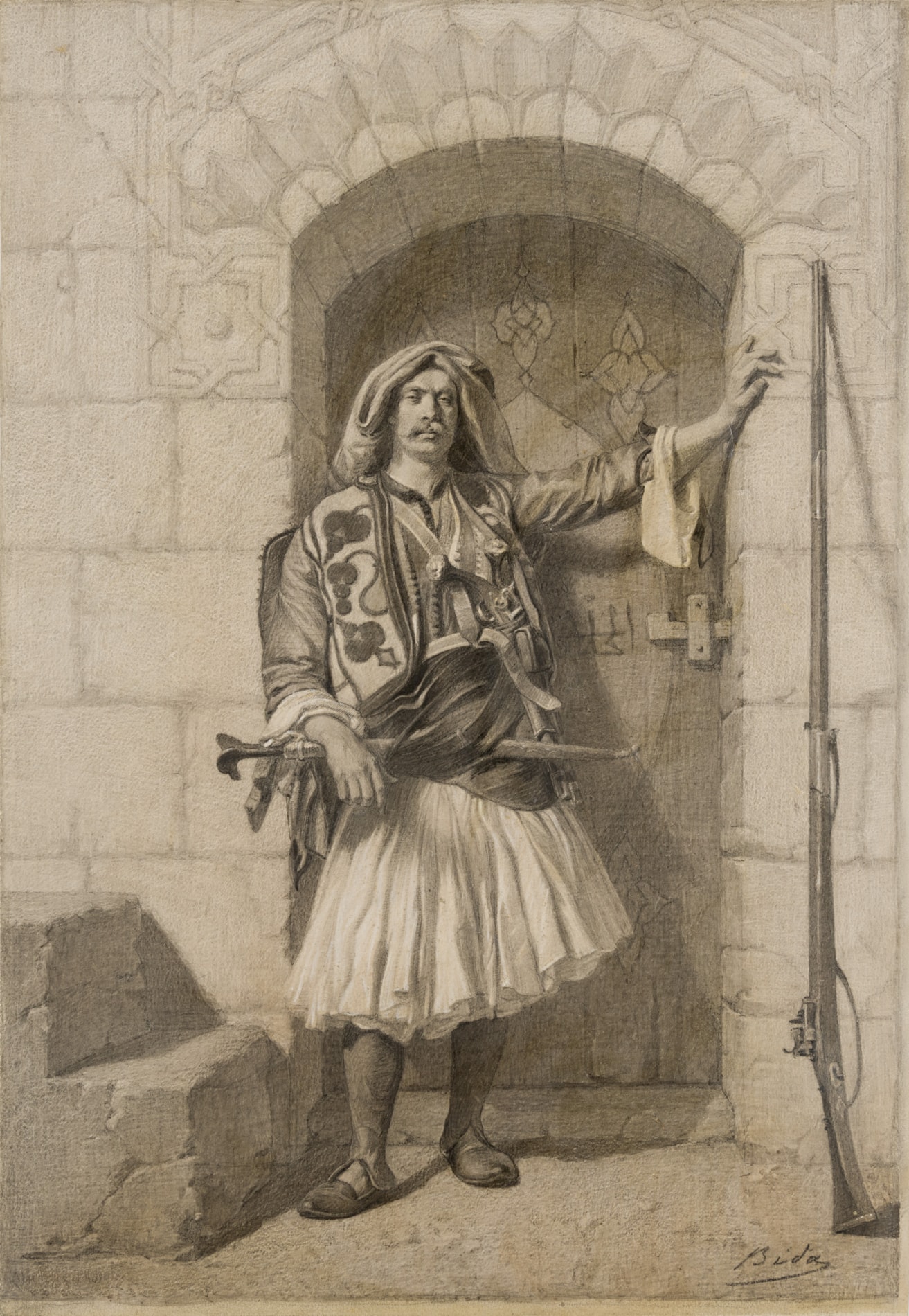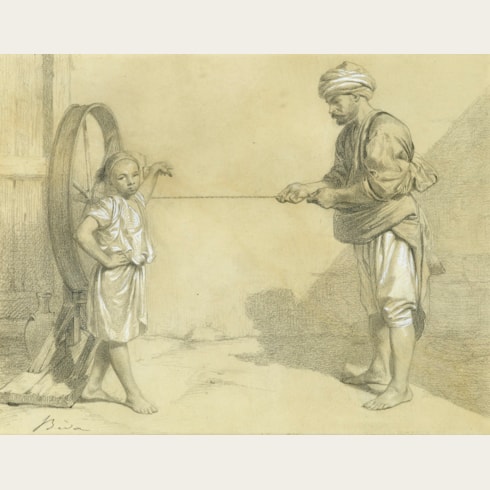Alexandre BIDA
(Toulouse 1813 - Bühl 1895)
A Standing Arnavut Soldier
Sold
Black chalk, with touches of white heightening.
Signed Bida at the lower right.
Indistinctly inscribed in pencil at the lower left.
A small torn and repaired section at the right centre of the sheet.
Laid down.
400 x 275 mm. (15 3/4 x 10 7/8 in.)
Signed Bida at the lower right.
Indistinctly inscribed in pencil at the lower left.
A small torn and repaired section at the right centre of the sheet.
Laid down.
400 x 275 mm. (15 3/4 x 10 7/8 in.)
This fine drawing depicts an Arnavut (or Arnaut), an Albanian soldier used by the Pasha of Egypt, Muhammad ‘Ali, as the elite of his regular army. Predominantly Muslim, Arnavuts were a warlike mountain people from the region of Epirus, in the northwestern part of the Ottoman Empire. As described by a 19th century visitor to Cairo, ‘Their costume is artistically disheveled, their costly weapons as glittering as they are inoffensive, their proud and disdainful poses, their slightest gestures, everything about them seems to have been studied in its effect.’ Albanian soldiers were to be found throughout the Near East and were particularly noted for their elaborate dress.
The poet Lord Byron, who employed a number of Arnavuts as his personal guards, praised their costume as ‘the most magnificent in the world, consisting of long, white kilt, gold-worked cloak, crimson velvet gold laced jacket and waistcoat, silver mounted pistols and daggers’. A contemporary of Byron’s further remarked that ‘The Albanians or Arnauts...are extremely fond of gold and silver ornaments in their dress...The wealthier Arnauts have the outer vest of velvet and gold, richly interwoven with elegant ornaments...The breeches which are white are tied below the knees with a coloured garter...’
Albanian soldiers appear frequently in Alexandre Bida’s oeuvre, as well as in the lithographs he produced for two albums entitled L’Orient pittoresque and Souvenirs d’Egyte. A finished drawing of an Arnaut Guardroom in Cairo was exhibited by Bida at the Salon of 1859 - although the work is now lost, its appearance is known from a 19th century photographic reproduction - while a closely related drawing of Arnaut soldiers playing chess is in the Fodor collection at the Amsterdams Historisch Museum. A similar finished drawing by Bida of a standing Albanian soldier is in the Musée Jacquemart-André in Chaalis, and also comparable is a drawing of Two Albanians is in the collection of the Baltimore Museum of Art. Another finished chalk drawing of a standing Arnavut by Bida, on blue paper, is in a private collection in London.
The poet Lord Byron, who employed a number of Arnavuts as his personal guards, praised their costume as ‘the most magnificent in the world, consisting of long, white kilt, gold-worked cloak, crimson velvet gold laced jacket and waistcoat, silver mounted pistols and daggers’. A contemporary of Byron’s further remarked that ‘The Albanians or Arnauts...are extremely fond of gold and silver ornaments in their dress...The wealthier Arnauts have the outer vest of velvet and gold, richly interwoven with elegant ornaments...The breeches which are white are tied below the knees with a coloured garter...’
Albanian soldiers appear frequently in Alexandre Bida’s oeuvre, as well as in the lithographs he produced for two albums entitled L’Orient pittoresque and Souvenirs d’Egyte. A finished drawing of an Arnaut Guardroom in Cairo was exhibited by Bida at the Salon of 1859 - although the work is now lost, its appearance is known from a 19th century photographic reproduction - while a closely related drawing of Arnaut soldiers playing chess is in the Fodor collection at the Amsterdams Historisch Museum. A similar finished drawing by Bida of a standing Albanian soldier is in the Musée Jacquemart-André in Chaalis, and also comparable is a drawing of Two Albanians is in the collection of the Baltimore Museum of Art. Another finished chalk drawing of a standing Arnavut by Bida, on blue paper, is in a private collection in London.
Regarded in his day as one of the finest draughtsmen of the 19th century, Alexandre Bida abandoned a career as a teacher of classics to study with Eugène Delacroix in Paris. It was the influence of Delacroix, as well as the work of Gabriel-Alexandre Decamps and Auguste Raffet, that led Bida to be interested in Orientalist themes and subjects. An early visit to Syria and Constantinople instilled in him a fascination with Near Eastern subjects, and at his Salon debut in 1847 he showed two highly finished drawings of A Cafe in Constantinople and A Cafe on the Bosphorus; both works were purchased by the State. Bida visited Egypt in 1850, and Greece, Turkey and the Crimea in 1855, and continued to exhibit regularly at the Salons, showing almost nothing but finished drawings. In a letter of 1870, the painter Eugène Fromentin praised Bida’s draughtsmanship, noting that ‘his drawings are paintings without colour or engravings that did not pass under the burin, but have the same value and weight.’ Bida also undertook a number of projects for book illustrations, notably a series of the collected works of Molière in 1860 and of Alfred de Musset in 1865, as well as an extensively illustrated Bible published by Hachette in 1875. He was also a prolific lithographer. Large groups of drawings by the artist are today in the Louvre and the museum at Pontoise.
That Bida’s drawings were widely praised even outside France can be seen in the comments of an anonymous critic, writing in an English periodical of 1859, who noted that ‘Amongst the most noteworthy things of the kind of our day are M. Alexandre Bida’s masterly crayon drawings. They combine in a remarkable degree boldness and freedom of outline with a soft and brilliant finish, producing the effect of colour with colourless materials. But what is still more essential is the ripe study and appreciation of character, and the keen eye for the picturesque, displayed by the artist on all occasions. His sphere of action has hitherto been chiefly confined to Oriental climes, from which he has brought home some beautiful works, but we have no doubt that when he chooses to apply himself to other themes he will acquit himself in a way to increase the renown he has already attained.’
Provenance
Webster House, Kansas City, Missouri.





